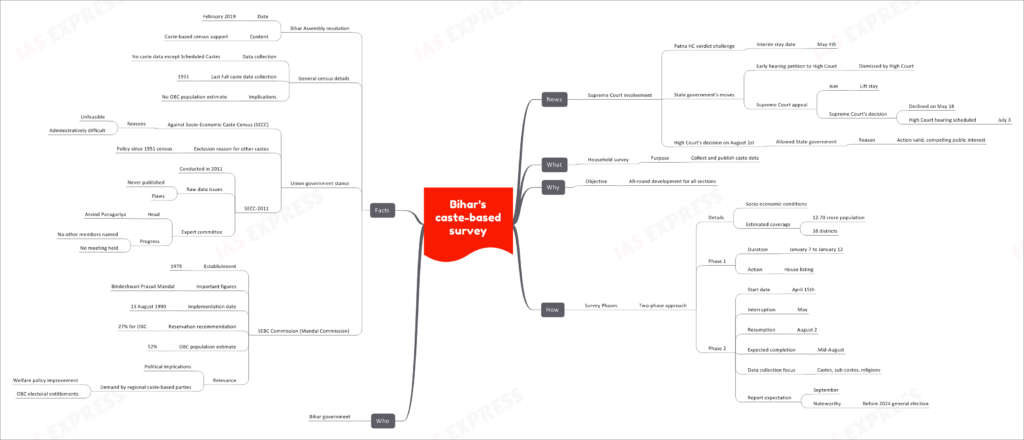Bihar’s caste-based survey

A recent development has brought Bihar’s caste-based survey to the forefront, sparking debates and discussions on the implications of such an initiative. The involvement of the Supreme Court, the survey’s objectives, the survey phases, and the historical context all contribute to the intricate tapestry of this issue.
Supreme Court’s Involvement: A Legal Quandary
The Supreme Court’s engagement in this matter stems from a challenge to the Patna High Court’s verdict, leading to an interim stay issued on May 4th. The state government’s efforts to expedite the process included an early hearing petition, which was dismissed by the High Court. Subsequently, the state government appealed to the Supreme Court, aiming to lift the stay. However, the Supreme Court declined this appeal on May 18th, and the High Court scheduled a hearing for July 3rd. Eventually, on August 1st, the High Court ruled in favor of the state government, allowing the survey to proceed due to its compelling public interest.
The Caste-Based Survey: Unveiling the What and Why
The essence of Bihar’s endeavor revolves around a comprehensive household survey, intended to collect and subsequently publish caste data. The underlying objective is to foster all-round development for every section of the population, addressing the needs and disparities faced by various caste groups.
The Survey’s Execution: Phases, Methods, and Timeline
The survey unfolds in two distinct phases, each catering to specific aspects of socio-economic conditions across the state’s 38 districts, covering an estimated population of 12.70 crore.
- Phase 1 (January 7 to January 12): This phase involved house listing, capturing basic demographic information.
- Phase 2 (Started on April 15, Resumed on August 2, Expected Completion in Mid-August): This phase is centered around collecting detailed data related to castes, sub-castes, and religions. The data collection focus underlines the intricate social fabric of Bihar.
The comprehensive report, reflecting the survey’s outcomes, is anticipated to be available in September, a notable timing given the upcoming 2024 general election.
Key Players: Bihar Government and Assembly Resolution
The driving force behind this survey is the Bihar government, committed to addressing societal disparities and fostering inclusive development. This effort finds its roots in a 2019 Bihar Assembly resolution, which advocated for a caste-based census to gain insights into the state’s socio-economic landscape.
Historical Context: Census Data and Government Stance
Bihar’s pursuit of caste data is underscored by a historical lack of comprehensive census data, especially concerning castes beyond the Scheduled Castes. The last full caste data collection was in 1931, leaving a significant knowledge gap, especially regarding the OBC population.
The Union government’s stance against the Socio-Economic Caste Census (SECC) is based on logistical and administrative difficulties. Additionally, the exclusion of caste data collection for other groups, except the Scheduled Castes, has been a policy since the 1951 census.
The SECC-2011 and Mandal Commission: Past Efforts and Challenges
The SECC-2011, conducted in 2011, remains unpublished due to raw data issues and flaws. An expert committee, led by Arvind Panagariya, has not made substantial progress. The Mandal Commission, established in 1979, recommended a 27% reservation for OBCs and estimated their population at 52%. This commission’s significance lies in its political and electoral implications, catering to the demands of regional caste-based parties and advocating for welfare policy improvement and OBC electoral entitlements.
If you like this post, please share your feedback in the comments section below so that we will upload more posts like this.

